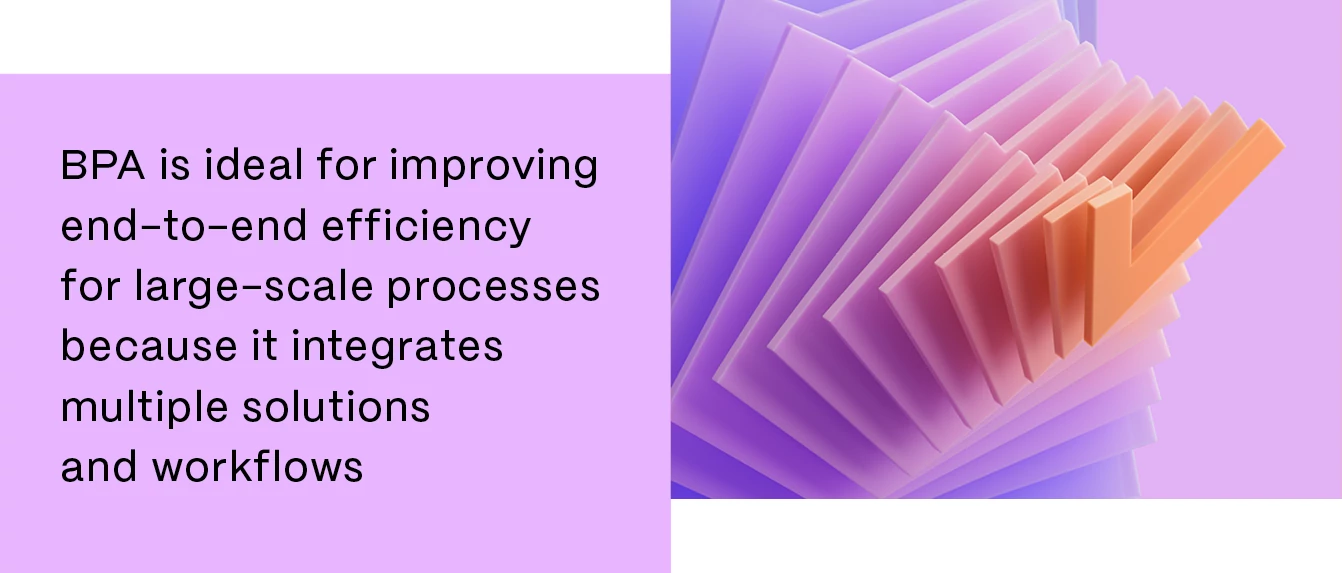
Blog
Ultimate guide to business process automation

What is business process automation?
Business process automation (BPA) means leveraging technology to automate a company’s daily tasks and operations. BPA takes over tedious yet necessary steps of business processes to enable maximum efficiency. It’s an important tool to streamline operations and allow your company to get the most out of staff and resources. It has the added benefit of freeing up time for staff to do more thoughtful, strategic work, which can increase business outcomes and employee satisfaction.
By 2026, only 2 years away, the business process automation market is projected to reach $19.6 billion. With such a high value placed on BPA, it seems companies across industries agree: in today’s competitive business landscape, BPA is necessary to gain an advantage and stay ahead.
What are the different types of business process automation
BPA can be customized to the exact requirements for your business and encompass a range of solutions. These can incorporate different combinations of software platforms, low-code or no-code technologies, and AI systems. Some examples of these solutions include:
- Task automation: Eliminates or minimizes manual tasks within a process.
- Workflow automation: Automates tasks within a workflow, such as approvals and assignments.
- Robotic process automation (RPA): Uses bots to perform repetitive tasks, often mimicking human actions. We’ll discuss this in detail later in this guide.
- Intelligent process automation: Incorporates AI and machine learning in more complex processes to enhance decision making and efficiency.
What are the steps in business process automation
Here are a few simple steps to automate business processes:
- Identify processes: Figure out which processes are suitable for automation. This might include setting up meetings, creating reports, and updating databases.
- Define objectives: Clarify why you want to automate processes. Outline what you hope to achieve, such as faster service delivery or greater efficiency for internal operations.
- Choose tools: Research tools and vendors that will meet your objectives for process automation and invest in those technology solutions.
- Track and evaluate results: Continuously monitor results and analyze data to ensure you're meeting your goals. Make adjustments as necessary.
What is the difference between RPA and BPA?
BPA is sometimes confused with RPA. These two terms have similarities, but they are not the same. Read on to find out what sets them apart.
What is RPA (robotic process automation)?
Robotic process automation (RPA) is technology that deploys software robots to automate repetitive rule-based tasks.
These software robots can interact with digital applications the way humans do — extracting data, understanding what’s on a display, and inputting keystrokes. RPA typically carries out tasks such as data entry, data extraction, report generation, and process monitoring. It has many applications across industries, from automating transactions for finance companies to processing patient data for healthcare organizations.
Comparing RPA and BPA
While RPA focuses on using software bots to complete rule-based tasks, BPA is a broader category that defines how business processes are automated from start to finish. It can incorporate multiple systems and approaches.
Because it integrates many solutions and workflows, BPA is ideal for improving the end-to-end efficiency of large-scale processes. RPA, however, is best for optimizing a single specific workflow, because bots have to be programmed for each task they need to complete.
For example, at a financial services company, BPA might be used to manage loans from start to finish, streamlining document preparation, review, and approvals. RPA could be used to speed up the process of approving loan applications.

What are examples of process automation?
Wondering what business processes can be automated? Practically any, but the following are examples of some that may be more suited to it than others.
Employee onboarding
BPA can take over tedious onboarding tasks such as sending documents, assigning training, and setting up meetings. Automations for standard onboarding workflows help new employees settle in faster and save time for HR professionals.
Accounts payable
You can issue payments more efficiently and build strong vendor relationships by automating invoice processing, data entry, and approvals for accounts payable.
Document management
Using BPA lets you streamline contract management from beginning to end. Automations to more efficiently collaborate on documents make for seamless business operations.
Sales and marketing
You can boost sales by using BPA to generate leads, manage email marketing campaigns, and run audience analytics. Automating repetitive processes also frees up more time for strategic marketing initiatives.
Related Read: How automation enables Kandio to operate without boundaries
[H2] Tools to automate business processes
To reap business process automation benefits, companies can use technology to automate a range of processes. The two main tools to use are custom workflow automation and enterprise solutions.
[H3] Custom workflow automation
Custom workflow automation tools let businesses design, implement, and manage automated workflows tailored to specific needs. These tools streamline operations, reduce errors, and improve efficiency.
Enterprise solutions
Enterprise-level BPA tools and solutions offer comprehensive automation capabilities for complex, large-scale business processes. An enterprise-level tool can integrate various business functions, such as accounting, human resources, and sales within a single platform. It also provides advanced analytics and supports regulatory compliance. It's crucial for a business to choose software suitable for its size and stage of development.
Features of business process automation tools
When choosing a technology partner for BPA, consider whether or not the software includes these key features to optimize operations:
- Unified platforms: Centralized systems that connect modules for seamless data flow.
- Application programming interfaces (APIs) and connectors: Tools that allow different software applications to integrate with each other.
- Data integration: A feature that brings in data from diverse sources to generate useful insights.
- Automated workflows: Workflows with built-in automated steps to reduce errors and increase efficiency.
- Shared databases: Consolidated storage that makes it easy for staff to access information and assets.
- Security and compliance: Features that align with the latest data security policies, helping businesses adhere to regulations and protect sensitive information.
5 key benefits of BPA
Using tools to automate business processes provides significant advantages. Below, explore five top benefits of using BPA to better manage large-scale processes.
1. Increased productivity and efficiency
By automating repetitive tasks, BPA minimizes the time employees spend on mundane work. This helps staff get more done at a faster pace and reduces error rates — necessary elements if you want to maintain a competitive advantage. By 2030, it’s estimated that activities taking up 30% of hours worked in the US could be automated.
2. Improved accuracy and compliance
Using BPA to automate tasks reduces human error. It leads to increased accuracy for repetitive activities such as data entry. Automation tools that consistently apply up-to-date industry standards and regulations can also provide peace of mind that your operations are compliant.
3. Reduced costs
Automating repetitive tasks can lead to significant cost-savings as it decreases the need to correct mistakes and enhances overall efficiency. BPA enables better resource allocation, giving you more funds for strategic initiatives that set your business apart from competitors.
4. Enhanced customer experience
Automation can result in faster service delivery by boosting efficiency with streamlined workflows. It can instantly process tasks that take longer to complete manually. High volumes of requests can be more efficiently managed, reducing customer wait times. BPA can also produce higher quality work that delights customers by delivering products and services with fewer mistakes.
5. Robust performance reporting
BPA performance reports help catch mistakes as they occur. This immediate feedback allows for quick intervention to resolve problems. These reports also help analyze errors, identify root causes, and ultimately improve process efficiency and

over time.
How to improve business process automation
With the right approaches, your business can enhance BPA to reap the benefits listed above. Here are some key tactics:
- Automate the right processes: Automate tasks that are repetitive, time-consuming, or prone to errors, especially those that have a big impact on your business. Consider the examples listed above, such as accounts payable and document management, as you assess whether or not you’ve chosen the right processes to automate.
- Analyze processes: Think critically to determine how your automated processes are currently meeting your goals. Assess if there are new opportunities for automation using existing tools, such as using AI to automate research processes, ensure regulatory compliance, or enhance decision-making with insights.
- Optimize continuously: Keep tabs on how well your BPA solutions are performing using analytics. Spot areas where you can improve and make adjustments to boost efficiency. Regular audits ensure everything stays on track with regulations.
- Engage stakeholders: Use stakeholders across teams to advocate for your automation solutions, whether implementing or adjusting BPA. This increases a company’s rate of adoption for time-saving technology.
Streamline business processes with automation
BPA is a crucial component of modern day business. It can be implemented through a variety of solutions, and the steps to get started can vary. By using BPA to manage processes with repetitive steps, such as new employee onboarding, accounts payable, and sales, you can increase efficiency and ultimately save money.
By following the tips outlined in this guide, you can help ensure BPA is optimized for your business needs. Technology is the key to unlocking BPA benefits — find the right vendor to partner with and automate your processes to reach the most successful outcomes.
Related Resources

Blog